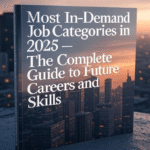ultimate guide to internships in 2025 : How to Find, Apply, and Succeed

Why internships in 2025 matter
The job market continues to evolve — automation, remote work, and new tech stacks change employer expectations quickly. Internships in 2025 give you:
- Hands-on experience: Practical projects that show employers you can deliver.
- Relevant skills: From technical tools to communication and remote collaboration.
- Network and mentorship: Connections that often translate into referrals and job offers.
- Industry insight: An early look at company culture and career paths.
Because many employers test candidates through internships before offering full-time roles, a strong internship can be the most reliable pathway from campus to career.
Types of internships you’ll see in 2025
Not all internships are the same. You should choose by goals, time availability, and desired learning outcomes.
- Paid vs unpaid: Paid internships (common in tech, finance, engineering) offer direct compensation. Unpaid internships may exist in NGOs, small startups, or creative fields — weigh value carefully.
- Remote: Virtual internships have become mainstream — great for geographic flexibility but require strong communication skills.
- Hybrid: Split between remote and on-site work — a compromise for collaboration-heavy teams.
- Co-op programs: Typically longer (6–12 months) and often part of university programs, offering deeper exposure.
- Micro-internships: Short (a few days to weeks) project-based internships useful for quick experience and testing interest in a field.
Where to find top internship programs
Start with a mix of broad and targeted search channels:
- University career centers: Many companies post internships exclusively to campus job boards.
- Company career pages: Visit target employers’ websites and sign up for alerts.
- Major job boards: (e.g., LinkedIn, Handshake, Indeed) — use filters for internships and 2025-specific openings.
- Industry-specific platforms: For tech: GitHub Jobs / Stack Overflow Jobs-type listings; for creative: Behance / Dribbble.
- Professional associations: Many professional bodies list internship opportunities and scholarships.
- Networking: Referrals from alumni, professors, or LinkedIn contacts — often yield the most competitive roles.
Pro tip: Set job alerts for the focus phrase “Internships in 2025” and related queries so new postings reach your inbox the moment they appear.
How to apply — the step-by-step playbook
Apply like a pro. Use this checklist for each application:
- Research the role & company: Understand the team, tech stack, and projects.
- Tailor your résumé: Highlight relevant coursework, projects, and measurable results.
- Write a targeted cover letter: Address the hiring manager or recruiter when possible; explain what you bring and what you want to learn.
- Submit any requested work samples or portfolio links: Use GitHub, Behance, or a personal website.
- Follow application instructions exactly: Companies often screen for attention to detail.
- Send a polite follow-up: If you haven’t heard in 10–14 days, a brief follow-up message can show continued interest.
Perfecting your application assets
Résumé (CV)
Focus on clarity and relevance. For internships, recruiters look for:
- Contact details and a concise professional summary (1–2 lines).
- Education, GPA (if strong), relevant coursework.
- Projects with measurable outcomes (e.g., “Built a REST API used by 200+ users”).
- Technical and soft skills (tools, languages, collaboration, leadership).
Cover Letter
Keep it to one paragraph that explains:
- Why you’re excited about the role.
- One or two examples of relevant experience.
- How the internship aligns with your career goals.
Portfolio / Work Samples
Always include direct links. For technical roles, include GitHub repos with clear READMEs; for design, include annotated case studies.
Interview prep & virtual assessment tips
Interview formats for internships may include phone screens, behavioral interviews, technical challenges, and virtual assessment centers.
Behavioral interviews
Use the STAR method (Situation, Task, Action, Result) to structure answers. Prepare short stories about teamwork, conflict resolution, learning from mistakes, and leadership.
Technical interviews
Practice fundamentals — data structures, algorithms (for tech), or case studies (for consulting). Time-box practice sessions and review coding problems on platforms like LeetCode or HackerRank.
Virtual assessments
For online assessments, ensure a quiet space, stable internet, and all required software installed. Read instructions carefully; pacing is often a common mistake.
Questions to ask the interviewer
- What does a typical day look like for an intern on this team?
- How will success be measured?
- What mentorship or training is provided?
How to succeed once you get the internship
Landing the role is step one — thriving is step two. Use these daily and weekly habits:
- Be proactive: Volunteer for tasks and ask how you can add value.
- Communicate clearly: Provide progress updates and ask clarifying questions.
- Seek feedback: Ask for mid-internship reviews and act on suggestions.
- Document your work: Keep notes and create a short portfolio of completed tasks.
- Network: Arrange short coffee chats (virtual or in-person) with teammates to learn about career paths.
Delivering visible impact, even in small projects, makes you memorable.
Turning the internship into a full-time offer
Many interns convert into permanent hires. To increase your odds:
- Deliver high-quality, timely work.
- Align your goals with the team’s priorities.
- Express interest in full-time roles early — discuss career paths with your manager.
- Keep relationships strong: mentors and managers are the best advocates for offers and referrals.
If a full-time role isn’t available at the host company, use the internship experience to strengthen your applications elsewhere — request recommendation letters and ask for project summaries you can share.
Top internship programs & industries to consider in 2025
Certain industries and companies are especially active in internships:
Tech & Software
Large tech companies and fast-growing startups offer structured intern programs with mentorship, hackathons, and rotations. Roles: Software Engineering, Data Science, Product Management, UX/UI.
Finance & Consulting
Internships in finance and consulting are usually competitive but highly structured, offering intensive training and networking. Roles: Investment Banking Analyst Intern, Strategy Consulting Intern.
Healthcare & BioTech
Lab internships, clinical research, and product roles are available for students with relevant backgrounds.
Creative & Media
Marketing, content creation, design, and editorial internships build portfolios and industry contacts.
Public Sector & NGOs
Useful for policy, international development, and nonprofit experience — often lower pay but high impact and networking in specialized sectors.
Note: When choosing a sector, weigh compensation, the quality of mentorship, and the relevance of projects to your career goals.
Resources & next steps
Use these resources to stay organized and competitive:
- Build a tracking spreadsheet: Track company, role, deadline, application status, contacts, follow-ups.
- Up-skill quickly: Short online courses (MOOCs) or bootcamps that teach tools used in desired roles.
- Portfolio & GitHub: Keep projects documented with READMEs and live demos if applicable.
- Alumni & mentors: Ask alumni for informational interviews and mock interview practice.
Suggested external links (replace or adjust as needed):
Frequently Asked Questions (FAQ)
Q: When should I start applying for 2025 internships?
A: Start researching and preparing 3–6 months before the internship start date. Many competitive programs open applications 4–9 months in advance.
Q: Are unpaid internships worth it?
A: They can be, but only if the learning and networking value outweigh the cost. Prefer paid roles when possible; negotiate if responsibilities are significant.
Q: How do I stand out as a student with little experience?
A: Highlight projects, classwork, volunteer experience, and any freelance work. Create a portfolio and show curiosity and initiative during interviews.
Conclusion — make 2025 your launch year
Internships in 2025 are powerful stepping stones. With a strategic search, tailored applications, and strong in-role performance, you can transform short-term placements into long-term career momentum. Start early, stay organized, and treat every internship as both a learning opportunity and a chance to make meaningful professional connections.
read more : 1. Top Internship Programs in 2025






